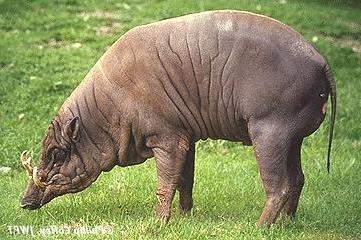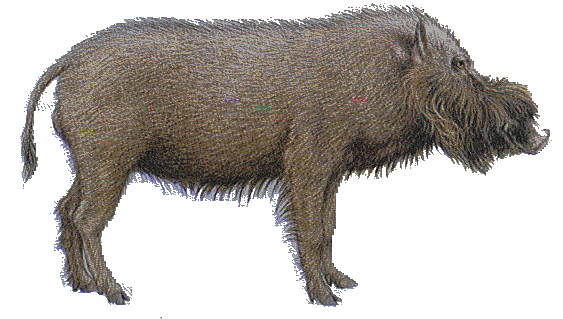Wild pig dynamics
It is becoming increasingly appreciated that to understand and predict the extinction-risk threatening a species, requires models that can incorporate both spatial heterogeneities and stochastic dynamics. The heterogeneities usually arise do to how easily an area can be reached and its population exploited. Conservation methods that utilise spatial structure (such as the development of marine-reserves or fishing exclusion-zones off the Australian coast) have been highly successful.
Babirusa
 Previous work has considered two species of wild-pig on the island of Sulawesi: the Babirusa which is endangered and the Sulawesi wild-pig which is far more abundant. Here, heterogeneities arise from two main sources (i) the presence of the only pig-meat market in the extreme North-East of the region in association with the poor road access to many regions means that hunting tends to be localised, (ii) the destruction of habitat through logging is reducing the population of both these pig species and therefore increasing the hunting pressure on the remaining populations.
Previous work has considered two species of wild-pig on the island of Sulawesi: the Babirusa which is endangered and the Sulawesi wild-pig which is far more abundant. Here, heterogeneities arise from two main sources (i) the presence of the only pig-meat market in the extreme North-East of the region in association with the poor road access to many regions means that hunting tends to be localised, (ii) the destruction of habitat through logging is reducing the population of both these pig species and therefore increasing the hunting pressure on the remaining populations.
A detailed spatial model was developed which incorporated simple economics for the hunters as well as the costs of travel times (from the hunting areas to the markets). This model predicted that one species - the Babirusa - was likely to be driven to extinction throughout most of its current range. Surpringly the most effective means of conserving the Babirusa was to increase the general standard of living for the Sulawesi region such that hunting was no longer an economically viable profession.
Bearded Pigs
 This project aimed to develop spatially-explicit population models of nomadic foragers in variable environments, using the Bornean bearded pig as a case study. Modelling focussed on three key components of forager spatial dynamics: population density, spatial distribution and movement dynamics. Model development progressed according the following objectives:
This project aimed to develop spatially-explicit population models of nomadic foragers in variable environments, using the Bornean bearded pig as a case study. Modelling focussed on three key components of forager spatial dynamics: population density, spatial distribution and movement dynamics. Model development progressed according the following objectives:
- Develop a non-spatial model linking bearded pig population density to temporal food supply fluctuations, using a 40-year time series of mass fruiting events in Borneo.
- Develop a spatial model investigating the link between forager aggregation, population density and unpredictability in the spatial food distribution.
- Extend the spatial model to investigate the link between optimal movement decisions, grouping behaviour, population density and unpredictability in the spatial food distribution
Our non-spatial model accurately predicted the observed times of bearded pig population eruptions over the 40 year period. We thus established a reliable model linking bearded pig population density to food supply levels, which was incorporated into a spatial model. This model incorporated a framework for modelling social behaviour in uncertain environments, and showed that uncertainty in the location of food sources, heterogeneity in the spatial food distribution and local population density drive aggregation behaviour. Extension of the model to investigate optimal patch departure strategies showed that these strategies were accurately predicted by traditional optimal foraging theory provided foragers had accurate knowledge of the local food distribution. This result is significant because the model violated key assumptions of optimal foraging theory; we have shown that this theory is more robust than previously thought. However, when forager uncertainty in food source location and social attraction/repulsion behaviours were incorporated, optimal patch departure times could not be accurately predicted by optimal foraging theory. This demonstrates that in uncertain foraging conditions, information gathering mechanisms including social behaviour have an important influence on animal movement.
Publications
PA Hancock, EJ Milner-Gulland, MJ Keeling (2006) Modelling the “many wrongs” principle: the navigational advantages of aggregation in nomadic foragers. J. Theoretical Biology 240 302-310
PA Hancock, EJ Milner-Gulland, MJ Keeling (2005) An individual-based model of bearded pig population abundance. Ecological Modelling 181 123-137.
PA Hancock, EJ Milner-Gulland, MJ Keeling (2004) Individual-based modelling of bearded pig abundance, Suiform soundings: newsletter of the IUCN/SSC Pigs, Peccaries, and Hippos Specialist Group, 4(2), 57-58.
MJ Keeling, EJ Milner-Gulland, L Clayton (1998) Spatial dynamics of two harvested wild pig populations Natural Resource Modelling 12 147-169
Funded by:
Darwin Initiative
Leverhulme Trust
People involved:
Matt Keeling
EJ Milner-Gulland (Silwood Park)
Lynn Clayton
Penelope Hancock (Silwood Park)


